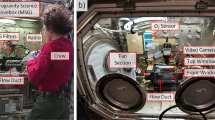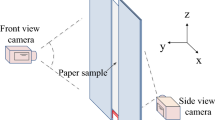Abstract
There are no existing experimental studies of flame spread rate trends for ultra-thin solid samples. Previous theory has predicted that for concurrent flame in kinetic regime, the flame spread rate decreases as the sample thickness decreases and there is a critical thickness below which burning is not possible. To test this hypothesis, a series of microgravity experiments of concurrent-flow flame spread over samples of ultra-low area densities are conducted using NASA Glenn Research Center’s Zero Gravity Research Facility (the 5.18 s drop tower). The tested samples are cellulose-based materials of various area densities, ranging from 0.2 mg/cm2 to 13 mg/cm2, as low as one order of magnitude less than those ever tested before. Each sample is 30 cm long by 5 cm wide and is burned in a low-speed concurrent air flow (5 to 30 cm/s). The results show that the concurrent flame spread rate is proportional to the flow velocity relative to the flame and is inversely proportional to the sample area density. A theoretical formulation, provided in this work, suggests that the flame length has a linear relationship with the relative flow speed and has no direct dependency on the sample area density. The experimental data supports this conclusion. From the images recorded in the experiments, a unique flame base tubular structure directed upstream away from the burnout zone is observed for thin samples. This structure is suspected to be due to flame stretching and localized blowoff caused by the oxidative pyrolysis Stefan flows at the sample burnout. This can be an indication that the chemical time becomes comparable to the flow time of the Stefan flow and the tested samples are approaching the kinetically-limited thickness. For the thinnest tested sample (0.2 mg/cm2), flames with concurrent and opposed dual natures are observed when the air flow rate is low (< 20 cm/s). At the lowest tested flow rate (5 cm/s), the flame spread rate exceeds the air flow rate and the flame transits to an opposed flame in the concurrent flow. The dual nature and flame transition are presented and discussed. This study provides detailed examination through high-resolution images of the transition between the concurrent to opposed flame spread modes.














Similar content being viewed by others
Notes
Any use of tradenames in this publication is for descriptive purposes only and does not imply endorsement by the U.S. Government.
Abbreviations
- D :
-
Species diffusivity
- \( k_{g} \) :
-
Gas-phase thermal conductivity
- L :
-
Latent heat of a solid fuel
- \( L_{f} \) :
-
Flame length
- \( L_{p} \) :
-
Pyrolysis length
- \( \dot{m}' \) :
-
Total burning rate of a sample per unit width \( ( = \rho \tau V_{f} ) \)
- \( \overline{{\dot{m}''}} \) :
-
Average burning rate of a sample \( \left( { = \frac{{\rho \tau V_{f} }}{{L_{f} }}} \right) \)
- \( \overline{{\dot{q}_{c} ''}} \) :
-
Average conductive heat flux
- Re :
-
Reynolds number
- Re x :
-
Local Reynolds number
- t :
-
Time after drop
- \( T_{f} \) :
-
Flame temperature
- \( T_{p} \) :
-
Pyrolysis temperature
- \( V_{f} \) :
-
Flame spread rate
- \( V_{rel} \) :
-
Relative flow velocity (concurrent, dual nature, and concurrent-reversed: \( V_{rel} = \left| {V_{\infty } - V_{f} } \right| \); opposed: \( V_{rel} = V_{\infty } + V_{f} \))
- \( V_{\infty } \) :
-
Forced flow velocity
- x :
-
Distance away from the upstream leading edge of a sample
- \( y_{f} \) :
-
Cross-stream location (away from sample surface) of a flame
- \( \alpha \) :
-
Gas-phase thermal diffusivity
- \( \rho \tau \) :
-
Sample area density
- \( \nu \) :
-
Kinematic viscosity
References
Olson SL, Miller FJ (2009) Experimental comparison of opposed and concurrent flame spread in a forced convective microgravity environment. Proc Combust Inst 32(2):2445–2452
Markstein GH, de Ris J (1973) Upward fire spread over textiles. Proc Combust Inst 14(1):1085–1097
Fernandez-Pello AC (1979) Flame spread in a forward forced flow. Combust Flame 36:63–78
Loh HT, Fernandez-Pello AC (1986) Flow assisted flame spread over thermally thin fuels. Fire Saf Sci 1:65–74
Saito K, Quintiere JG, Williams FA (1986) Upward turbulent flame spread. Fire Saf Sci 1:75–86
Tseng Y-T, T’ien JS (2010) Limiting length, steady spread, and nongrowing flames in concurrent flow over solids. J Heat Transf 132(9):091201-1–091201-9
Urban DL, Ferkul P, Olson S, Ruff GA, Easton J, T’ien JS, Liao Y-TT, Li C, Fernandez-Pello C, Torero JL, Legros G, Eigenbrod C, Smirnov N, Fujita O, Rouvreau S, Toth B, Jomaas G (2019) Flame spread: effects of microgravity and scale. Combust Flame 199:168–182
Li C, Liao Y-TT, T’ien JS, Urban DL, Ferkul DL, Olson S, Ruff GA, Easton J (2019) Transient flame growth and spread processes over a large solid fabric in concurrent low-speed flows in microgravity—model versus experiment. Proc Combust Inst 37(3):4163–4171
Zhao X, Liao Y-TT, Johnston MC, T’ien JS, Ferkul PV, Olson SL (2017) Concurrent flame growth, spread, and quenching over composite fabric samples in low speed purely forced flow in microgravity. Proc Combust Inst 36(2):2971–2978
Gollner MJ, Huang X, Cobian J, Rangwala AS, Williams FA (2013) Experimental study of upward flame spread of an inclined fuel surface. Proc Combust Inst 34(2):2531–2538
Olson SL, Ferkul PV, T’ien JS (1989) Near-limit flame spread over a thin solid fuel in microgravity. Symp (Int) Combust 22(1):1213–1222
Olson SL (1991) Mechanisms of microgravity flame spread over a thin solid fuel: oxygen and opposed flow effects. Combust Sci Technol 76:233–249
Sacksteder KR, T’ien JS (1994) Buoyant downward diffusion flame spread and extinction in partial-gravity accelerations. Symp (Int) Combust 25(1):1685–1692
Olson SL, Miller FJ, Jahangirian S, Wichman I (2009) Flame spread over thin fuels in actual and simulated microgravity conditions. Combust Flame 156(6):1214–1226
Jiang C-B (1995) A model of flame spread over a thin solid in concurrent flow with flame radiation. Ph.D. Dissertation, Case Western Reserve University, Cleveland, OH
Di Blasi C (1995) Influences of sample thickness on the early transient stages of concurrent flame spread and solid burning. Fire Saf J 25(4):287–304
Quintiere JG (2006) Fundamental of fire phenomena. Wiley, West Sussex
Hidaka Washi. http://japanese-paper.hidakawashi.com/paper-TENGU/index.html. Accessed 5 Oct 2018
White FM (2003) Fluid mechanics. McGraw-Hill, New York
Olson SL, T’ien JS (2000) Buoyant low-stretch diffusion flames beneath cylindrical PMMA samples. Combust Flame 121(3):439–452
Ferkul PV, T’ien JS (1994) A model of low-speed concurrent flow flame spread over a thin fuel. Combust Sci Technol 99:345–370
Kundu PK, Cohen IM (2004) Fluid mechanics, 3rd edn. Elsevier Academic Press, San Diego
de Ris JN (1969) Spread of a laminar diffusion flame. Symp (Int) Combust 12(1):241–252
Prasad K, Nakamura Y, Olson SL, Fujita O, Nishizawa K, Ito K, Kashiwagi T (2002) Effect of wind velocity on flame spread in microgravity. Proc Combust Inst 29:2553–2560
Acknowledgements
This work is supported by National Science Foundation under Award #1740478 (Division of Chemical, Bioengineering, Environmental, and Transport Systems) and NASA Glenn Research Center under Award #NNX16AL61A. We would also like to thank the crew members of the Zero Gravity Research Facility, Eric Neumann, Luke Ogorzaly, Mingo Rolince, Moses Brown, and Vittorio Valletta, for their tremendous help during the experiment operation.
Author information
Authors and Affiliations
Corresponding author
Additional information
Publisher's Note
Springer Nature remains neutral with regard to jurisdictional claims in published maps and institutional affiliations.
Rights and permissions
About this article
Cite this article
Vetturini, A., Cui, W., Liao, YT. et al. Flame Spread Over Ultra-thin Solids: Effect of Area Density and Concurrent-Opposed Spread Reversal Phenomenon. Fire Technol 56, 91–111 (2020). https://doi.org/10.1007/s10694-019-00878-w
Received:
Accepted:
Published:
Issue Date:
DOI: https://doi.org/10.1007/s10694-019-00878-w




